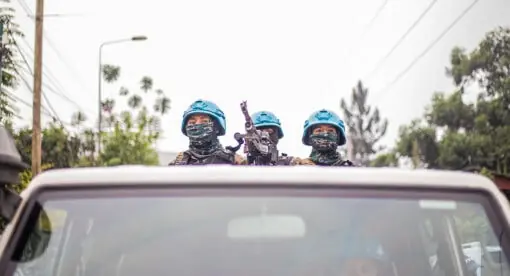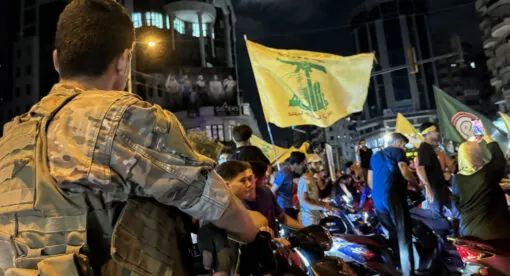The Weekly Forecast Monitor is a forward-looking assessment of geopolitical dynamics shaping our world. To get more in-depth analysis of these issues and learn more about analytical products from New Lines Institute — including simulations, training sessions, and forecast reports — contact us at [email protected] and visit https://newlinesinstitute.org/analytical-products/. Download PDF Version.
Listen to the Weekly Forecast Monitor podcast Here
Global Hotspots
The Global Hotspot Tracker examines the outlook for key geopolitical hotspots around the world. (Go to the Global Connectivity Tracker)
Russia/Ukraine Conflict
Summary – The Russia-Ukraine conflict is trending toward a diplomatic de-escalation scenario as Russia and the United States conducted a large-scale prisoner swap including high-profile journalists, while Ukrainian President Volodymyr Zelenskyy suggested his country could hold a referendum on territorial concessions to Russia. However, the military escalation scenario remains, as the U.S. delivered F-16 fighter jets to Ukraine.
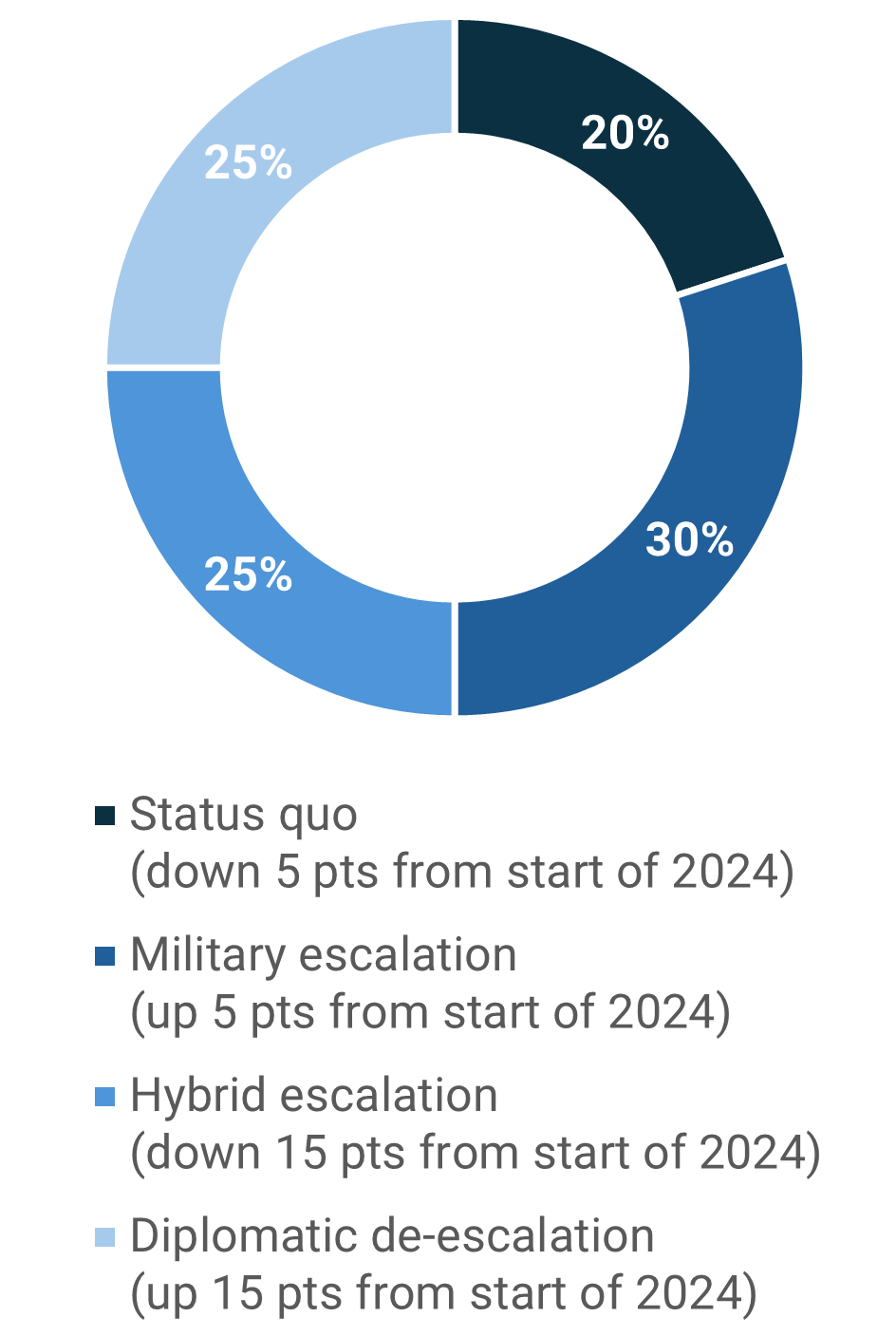
Military escalation scenario
- Ukraine received its first delivery of U.S.-made F-16 fighter jets from NATO countries. Kremlin spokesman Dmitry Peskov said Russia would shoot down the jets.
Risk level – medium - During a naval parade in St. Petersburg, Russian President Vladimir Putin threatened to resume production of intermediate-range nuclear weapons if the U.S. deploys its own missiles to Europe.
Risk level – low/medium
Hybrid escalation scenario
- Ukraine conducted its largest cyberattack against Russia, targeting the Russian central bank and impacting national payment systems, telecommunications providers, and social media networks.
Risk level – medium - Moldova launched an espionage case focused on the head of the Moldovan parliament’s legal department, with an employee of the Russian embassy in Chișinău declared persona non grata.
Risk level – low/medium
Diplomatic de-escalation scenario
- Russia and the West conducted one of the largest prisoner exchanges since the end of the Cold War, which included the release of U.S. journalist Evan Gershkovich and former U.S. Marine Paul Whelan.
Opportunity level – medium - Zelenskyy said he could call for a referendum on the issue of territorial concessions to Russia in exchange for peace ahead of planned negotiations later this year.
Opportunity level – low/medium
Middle East
Summary – Tensions in the Middle East trended toward military escalation as Israel carried out attacks on high-level leaders of Hamas and Hezbollah in Iran and Lebanon, respectively. Israeli Prime Minister Benjamin Netanyahu received the backing of the U.S. and his ministers to retaliate after a Hezbollah attack in the Golan Heights, significantly increasing the chances of a two-front war. Egypt and Qatar warned that cease-fire negotiations may be stymied by Israel’s attacks.
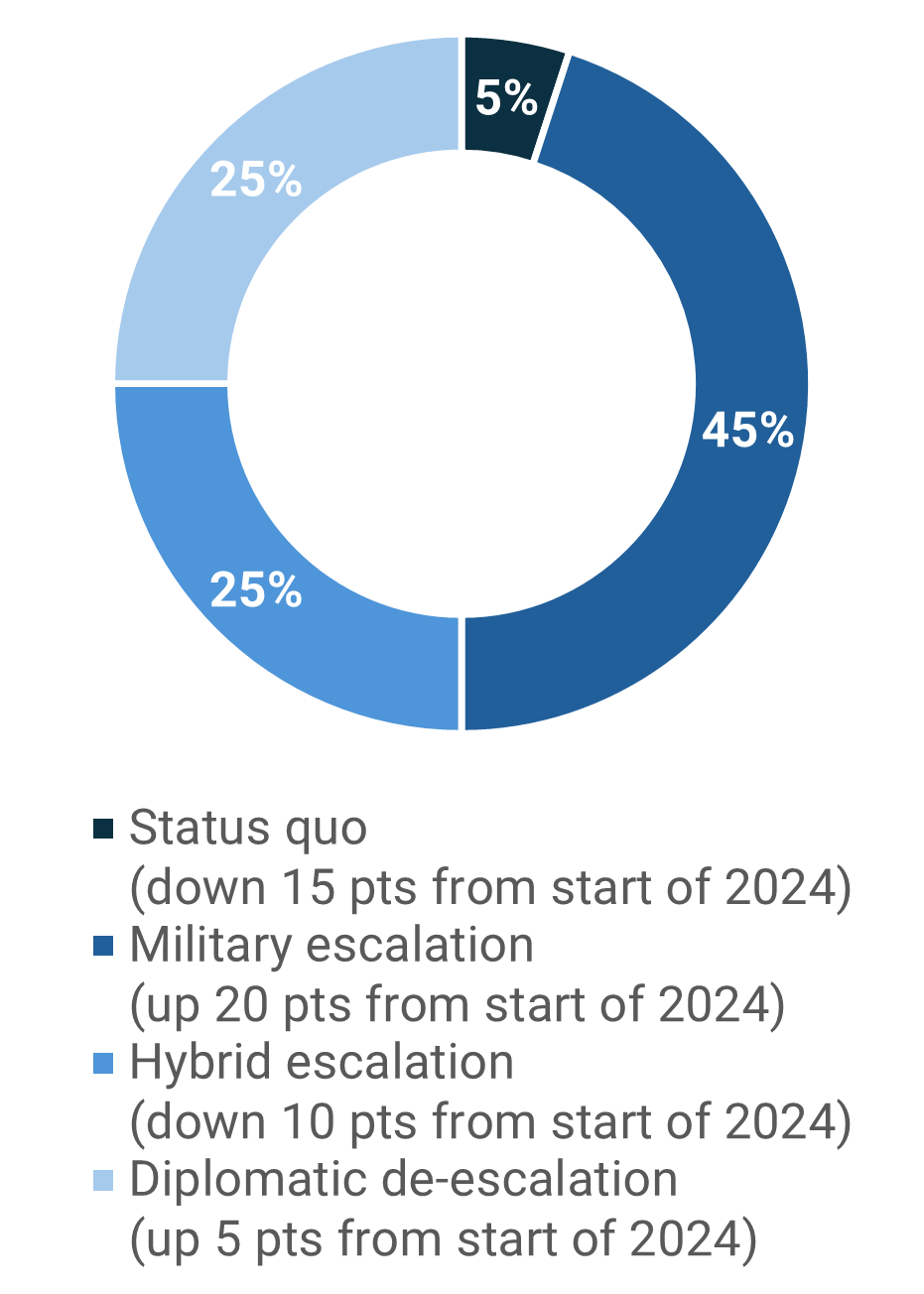
Military escalation scenario
- Israel assassinated Hamas leader Ismail Haniyeh in Tehran. Hamas responded by issuing a statement saying that the assassination would “take the battle to new dimensions and have major repercussions.” Iran declared three days of mourning and accused the United States of having a hand in the operation while vowing to retaliate for the attack. Iran planned a meeting with allies and proxies to discuss retaliation plans against Israel.
Risk level – medium/high - The Israel Defense Forces killed senior Hezbollah military commander Fuad Shukur in an airstrike in Beirut in retaliation for a Hezbollah rocket attack in the Golan Heights that killed 27 people. Israel’s security cabinet granted Netanyahu full control over the response to the attack, while Hezbollah leader Hassan Nasrallah said its war with Israel has “entered a new phase.”
Risk level – medium - The U.S. conducted airstrikes on a base in Iraq used by the Popular Mobilization Forces, killing four PMF members and injuring four others.
Risk level – low/medium
Hybrid escalation scenario
- Iran’s Islamic Revolutionary Guard Corps seized an oil tanker and arrested its crew, accusing them of smuggling fuel in the Persian Gulf.
Risk level – low - Israeli airstrikes have destroyed more than 30 water wells in Gaza over the past month, further restricting access to clean water.
Risk level – low
Diplomatic de-escalation scenario
- Qatar and Egypt noted that Haniyeh’s assassination would impede cease-fire negotiations.
Risk level – medium - UAE Foreign Minister Sheikh Abdullah bin Zayed Al-Nahyan spoke with U.S. Secretary of State Antony Blinken about efforts to prevent a regional war in the Middle East, including potential avenues for a cease-fire agreement and increased humanitarian aid.
Opportunity level – low
U.S./China/Indo-Pacific
Summary – Tensions in the Indo-Pacific continued to trend toward a military escalation scenario, as the United States announced substantial increase in military aid to the Philippines and established a joint forces headquarters in Japan. A bill that would mandate sanctions against China if it invades Taiwan was introduced in the U.S. Senate, and member states of the Quadrilateral Security Dialogue announced enhanced cooperation in cyber and maritime security. China took part in Russian naval exercises in the Baltic Sea.
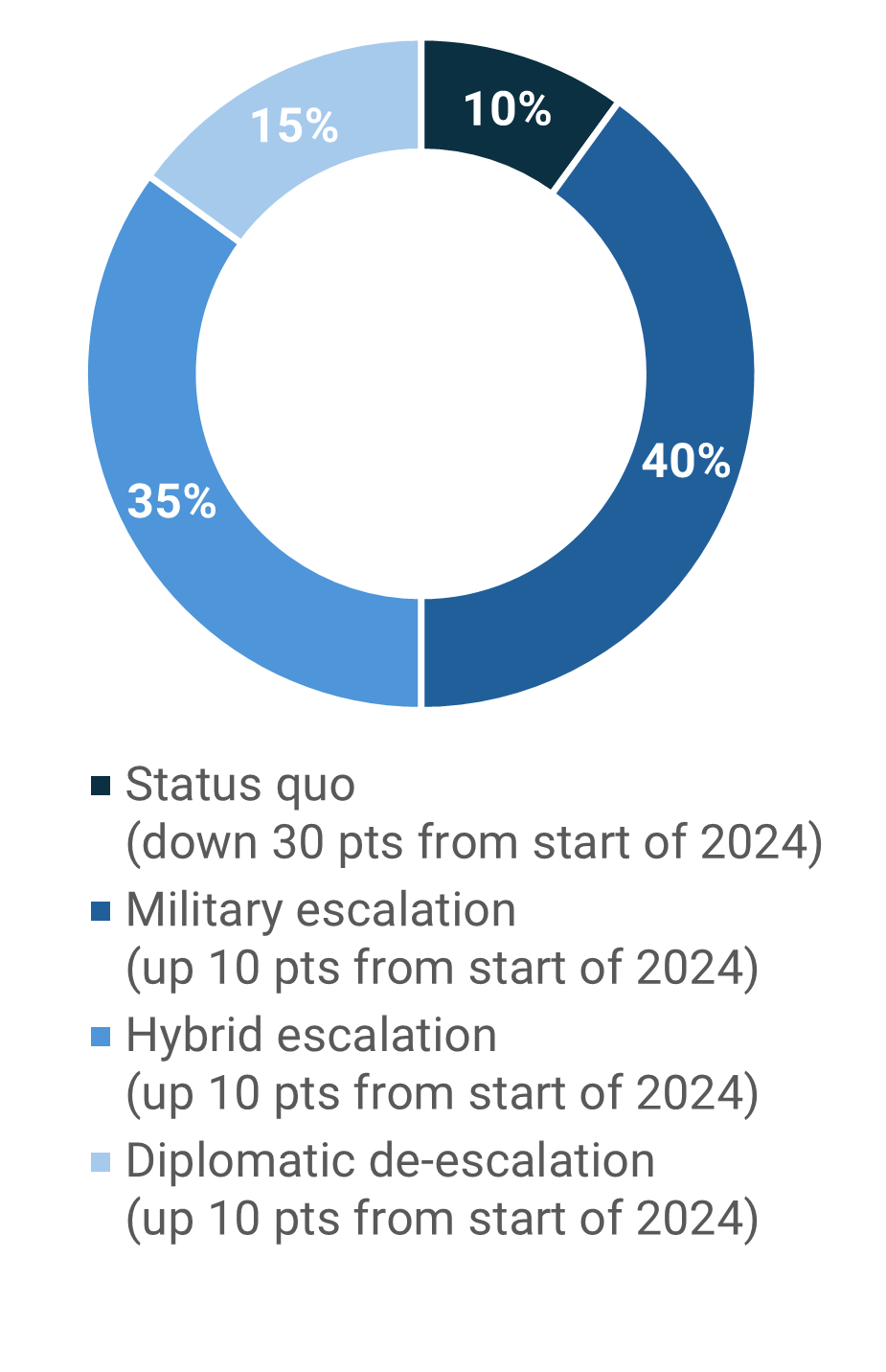
Military escalation scenario
- The U.S. announced $500 million in aid to the Philippines to modernize its military forces, adding to the Philippines’ 6.4% increase in defense expenditure for 2025.
Risk level – medium - Washington and Tokyo announced an upgrade to their military cooperation, under which U.S. forces in Japan would report directly to the commander of U.S. Indo-Pacific Command.
Risk level – medium - Forty-four Chinese ships and 60 Chinese aircraft deployed around Taiwan, with 47 aircraft crossing over the Taiwan Strait median line.
Risk level – low/medium - A People’s Liberation Army (PLA) Navy ship took part in a Russian navy search-and-rescue exercise in the Baltic Sea.
Risk level – low/medium - A Canadian warship, the HMCS Montreal, sailed through the Taiwan Strait as part of a freedom-of-navigation exercise.
Risk level – low/medium
Hybrid escalation scenario
- U.S. senators proposed a bill that would impose significant economic, financial, and energy sanctions on China in the event of PLA military aggression against Taiwan.
Risk level – medium - Foreign ministers of the United States, Australia, India, and Japan announced they would expand collaboration on cyber and maritime security in the Indo-Pacific.
Risk level – medium - Taiwan joined the Inter-Parliamentary Alliance on China (IPAC), a move China condemned.
Risk level – low/medium
Diplomatic de-escalation scenario
- Beijing officials are meeting with their U.S. counterparts in Washington to discuss further implementation of their bilateral agreement signed last fall aimed at restricting the illicit fentanyl trade.
Opportunity level – low/medium - The Philippines accused China of offering differing accounts of a resupply mission to Philippine troops stationed on the Second Thomas Shoal, going against their recent bilateral agreement.
Risk level – low/medium
Global Connectivity
The Global Connectivity Tracker examines the sectoral impact of geopolitical dynamics on key themes like the global energy/climate transition, trade, and technology. (Go to the Global Hotspot Tracker)
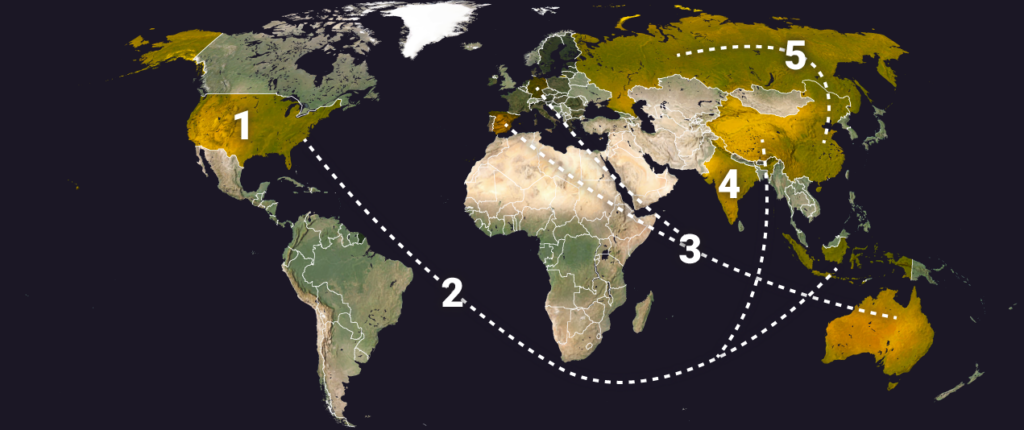
- United States: Energy
What happened: U.S. senators proposed a bill to reduce the amount of time needed for the approval of mining and energy projects.
Significance/Outlook: If passed, the measure would enhance U.S. energy security by expediting the permitting process for vital energy and mineral projects. It includes provisions for accelerating renewable energy permitting for offshore wind, upgrading grid infrastructure, improving electric reliability, and expediting liquefied natural gas export projects. This could result in lower energy pricing, the creation of domestic jobs, and the ability to maintain the U.S. position as a global energy leader. Such efforts could accelerate progress toward 2035 power sector decarbonization objectives while improving power system reliability and lowering electricity rates.
Opportunity level – low/medium - United States/Indonesia/China: Nickel
What happened: Indonesia aims to decrease Chinese investment in new nickel mining and processing projects to qualify for U.S. tax breaks.
Significance/Outlook: Indonesia took the step amid the Biden administration’s efforts to limit Beijing’s influence in the electric vehicle (EV) supply chain. Tax breaks under the Inflation Reduction Act that will be available starting in 2025 will not apply to EVs with batteries and critical minerals sourced from companies with over 25% Chinese ownership. Indonesia is the world’s biggest supplier of nickel, and maintaining diversity in this sector is a matter of national security, according to the deputy minister for investment and mining. Chinese companies, in turn, are unwilling to settle for minority stakes in nickel projects and are resisting attempts to restrict new investments.
Risk level – low - Germany/Spain/Australia: Green Hydrogen
What happened: Several recent developments in green hydrogen indicate that the technology, while not yet widely adapted, remains on track to serve a role in the carbon-free energy economy.
Significance/Outlook: In Germany, Shell Oil has given approval to develop a hydrolyzer at a refinery in the Rhineland capable of producing 44,000 kilograms of green hydrogen a day in a project expected to come online by 2027. Meanwhile, the European Commission has approved a $1.3 billion Spanish plan to spur investment in clusters of renewable hydrogen production. And in Australia, while mining conglomerate Fortescue backed off ambitious plans to produce 15 million metric tons of green hydrogen annually, citing the cost and energy requirements of the ambitious large-scale project, it did commit to spending $500 million over the next year to continue to develop green hydrogen. These developments indicate that large-scale production of green hydrogen appears to be several years away.
Opportunity level – low/medium - India: Critical Minerals
What happened: India is looking to develop critical mineral assets overseas to boost its energy transition efforts.
Significance/Outlook: India has two deep-sea mining licenses in the Indian Ocean and is now aiming to acquire additional licenses in the Pacific. The goal is to ensure access and a steady supply of critical metals like lithium, nickel, and copper, important steps for the country’s renewable energy transition. Coal India and a U.S. company are considering joint development of lithium assets in Argentina under the U.S.-led Minerals Security Partnership. India also is collaborating with Chile, a leading market for lithium and copper.
Opportunity level – medium - China/Russia: Dual-Use Technology
What happened: The flows of semiconductors and dual-use technologies arriving in Russia through China and Hong Kong significantly decreased between January and May.
Significance/Outlook: The U.S. and its allies have long accused China of supplying Russia with key technological components needed for it to support its war efforts in Ukraine, despite China’s stated neutrality in the conflict. Falling short of supplying finished weapons systems, China has increased its export of semiconductors, machine tools, and telecommunications equipment since 2022, which has played a major role in supporting Russia’s war economy. However, in 2024, the flow of these goods has decreased by up to 28% through Hong Kong and 19% through mainland China, in part due to increased targeted western sanctions against companies whose products end up on the battlefield.
Opportunity level – low/medium
Key Stats of the Week
- Nearly 70% of Russia’s machine tool imports and 90% of Russia’s microelectronics imports came from China in 2023.
- 200 Hong Kong-based firms were responsible for exporting nearly $2 billion worth of goods to Russia in the second half of 2023.
Sources: The Associated Press, Reuters


